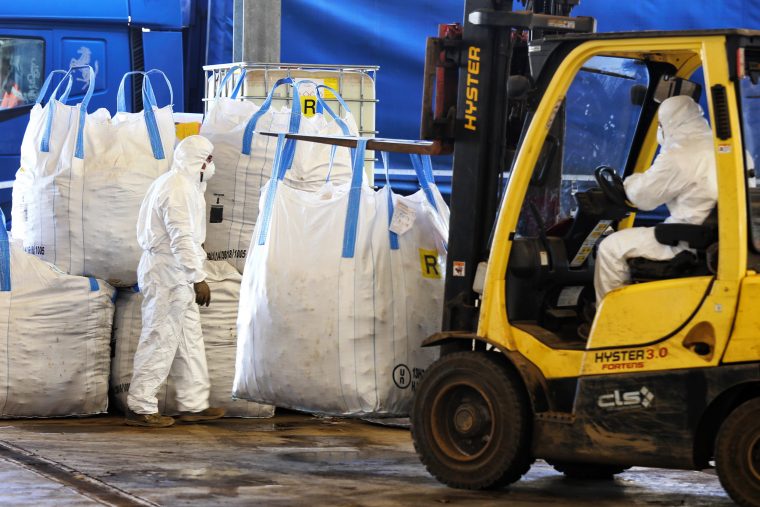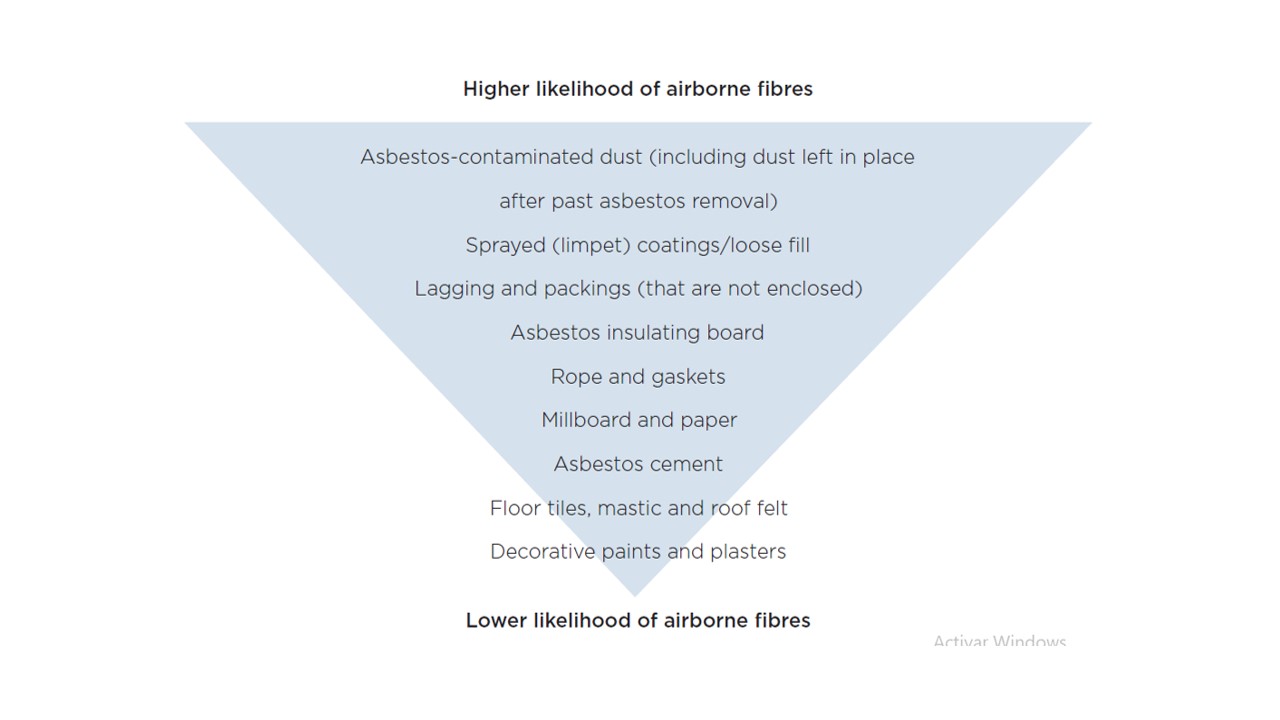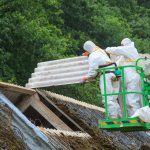PART III – ASBESTOS IN THE WORKPLACE
This section provides international principles on asbestos risk identification and management in workplaces. Although there are restrictions in place for amphibole asbestos, the information will assist workplaces to prepare for the public policy’s risk management of chrysotile asbestos.
The construction and demolition sectors should note that existing asbestos abatement public policy will be extended to include chrysotile asbestos management under the ban.
3.1 PRINCIPLES OF ASBESTOS RISK MANAGEMENT
The key principles of asbestos risk management in workplaces are for employers and persons with management and control of workplaces to:
1. identify the asbestos containing materials and products in workplaces
2. assess the risks of people’s exposure to asbestos fibres – including risks to employees, contractors, customers and anyone else that may be affected (e.g. neighbouring businesses or residents)
3. implement control measures that eliminate or minimise exposure to asbestos fibres
4. review and monitor the control measures to ensure they remain effective
5. consult with employees and other duty-holders during the whole process to:
- seek their input and gain support for the asbestos management plan, and
- keep them informed on risk controls.
Throughout this process it is advisable to draw on the expertise of competent asbestos professionals, asbestos removalists, waste transporters and disposal facility managers.
3.2 IDENTIFY ASBESTOS CONTAINING MATERIALS
As mentioned in Part I of this guideline, asbestos is not visible to the naked eye. If the building or plant was constructed or refurbished between 1942 and 1 January 2021, then asbestos containing materials (ACM) are highly likely to be present.
Asbestos containing materials (ACM) in good condition are safe if they remain undisturbed and undamaged.
Options to identify asbestos are:
1. Hire a competent person to conduct a full asbestos assessment of the premises. They may take samples to confirm the presence of asbestos in certain products.
or
2. Identify products that were manufactured or imported into Columbia that are likely to contain asbestos. Then for each product, either:
a. take a sample of the suspected asbestos and send it to a laboratory for testing, or
b. assume asbestos is present in those products and apply asbestos management controls
Research the history
Before conducting a physical assessment of the workplace, research the building’s history thoroughly to predict where asbestos may be. Questions that will help identify asbestos include:
Buildings:
- When was the building constructed?
- Are there original building plans or design specifications?
- Which materials were used to construct the building?
- What was the building used for in the past? (e.g. was there asbestos product manufacturing and is there a potential for residual dust and debris contamination?)
- What is the building currently being used for?
- What is the general condition of the site (eg operational or abandoned?)
Plant and machinery:
- What plant is installed in the building?
- Are there design plans of the plant?
- Where might the asbestos be in the plant (look for friction parts, such as gaskets, and for heat emission areas which may have asbestos heat lagging or protection)?
- Are there designers, manufacturers or suppliers of plant or plant parts that can provide information on potential asbestos parts?
People who have been involved with the workplace for a long time may be able to assist with the history e.g. workers, neighbouring businesses or residents.
Inspect the site to identify and record asbestos containing materials
Plan the inspection: Using plans of the buildings and plant, create a systematic plan to inspect the whole worksite, inside and out. Things to plan for:
- how to inspect areas or plant that require specialist entry
- should plant operation cease for the inspection
- what safety measures are required for the inspection team, e.g. work at height protection, small space entry requirements, and respiratory protection
- how to record the location and state of the asbestos (e.g. photographs, mark-up of plans, warning signs and labels)
Inspect the workplace: Search each room in a consistent manner and record each identified asbestos containing material. One search method would be to start with the floors; then walls and wall cavities; then ceilings and ceiling cavities; and finally inspect fixed and non-fixed plant, furniture, fire blankets and tools. Ensure the inspection includes internal and external areas of the buildings and plant. Here are sample lists of items to check:
Internal areas:
1. pipes: inspect the pipes for lagging or residue, brackets, elbows, as well as penetrations (for insulating products or packing materials) and walls adjacent to pipes where lagging may have over sprayed
2. ceiling cavities: inspect the insulation on beams or above false ceilings, if there are asbestos roof tiles or sheeting, inspect for damage, dust or deterioration on the underside
3. plant rooms: in general asbestos was used in water, heat and electrical containment (eg asbestos millboard surrounding heater banks in air-conditioning machinery); pipework, gaskets and flanges and valves; brackets and bitumen coated polystyrene insulation; boilers; hatch and other rope seals; electrical equipment including backing boards, fuses, bitumen coatings, rope, sheath and flash guards.
4. storerooms: for maintenance items such as gaskets, fuses etc.
5. fire and hot work equipment: fire doors (asbestos core), protective clothing (e.g. consider gloves used for hot work in foundries) and fire blankets
External areas:
1. walls, cladding, joints, infill panels, pipework or ductwork
2. rooftops and guttering: asbestos membrane waterproofing and note the condition of roofs for deterioration, fungus and debris
3. asbestos caulking, putty or mastics in windowsills, expansion joints and window frames
4. ground surface contamination with dust, fragments or discarded asbestos containing materials
5. water services pipework
Some areas may be inaccessible. Where this is the case, presume asbestos is present until there is evidence to the contrary.
During the inspection, record observations and photographs of the condition of each item. These records will become the Asbestos Register (refer to section 3.3 below).
Display warning labels and signs
Before commencing the inspection, obtain warning signs or labels to display on or near identified asbestos containing materials. Labels and signage used should adhere to Colombian and international principles to ensure national and international consistency.
3.3 CREATE AN ASBESTOS REGISTER
When identifying the asbestos containing materials, record observations into an Asbestos Register. An Asbestos Register is the foundation of the workplace’s asbestos management plan and should be provided to all workers and contractors so that they know where asbestos is located and can avoid disturbing or damaging it. It should include:
1. the product name and location
2. the type of material (e.g. lagging, cloth, asbestos cement)
3. whether it is friable or non-friable
4. the condition of the material
A template of an Asbestos Register is at Part VI – Information Sheet 1.
The condition of the product is particularly important. Observations to note include:
- Is the surface of the material damaged, frayed or scratched?
- Are the surface sealants peeling, “feathering” or breaking off?
- Is any sprayed material or lagging separating from the pipe or surface?
- Are protective coverings missing or damaged?
- Is there asbestos dust or debris near the material?
Table 1 below is a method for classifying the condition of the product.
Table 1 – assessing the condition of asbestos containing material
| Condition | Description |
| Good | · Firmly bonded
· Painted or sealed · no cracks or damage · no debris · no weathering or deterioration |
| Fair or Moderate | · Unpainted or unsealed
· Subject to minor or infrequent weathering · Friable but encapsulated (e.g. pipe lagging wrapped in plastic) · minor damage or deterioration (e.g. minor cracks or frayed edges) |
| Poor
Deteriorated Damaged Broken down Dilapidated |
· Un-bonded
· Unstable · Significant damage · Friable and damaged · Fire damaged · Visible debris and dust |
| Unknown | Only use when:
· Material is inaccessible · Area or room is inaccessible, but it is assumed to have ACMs within it |
Photographs (date-stamped) and sketches of the asbestos in place will record the condition of the ACM at that time. These can be used to track any changes in the material and indicate when removal or maintenance is required.
The Asbestos Register should be reviewed at least once a year to ensure it is up to date and to record any changes to asbestos materials. Other triggers for reviewing and updating the Asbestos Register include:
1. after an incident that impacts or may have impacted ACMs
2. replacement of ACM
3. when work has been done on or around ACM
3.4 ASSESS THE RISK OF EXPOSURE
Assessing the risk of exposure to asbestos fibres means understanding how likely it is for the fibres to be released and inhaled. The risk assessment takes three factors into consideration: the friability and type of material, the condition the product is currently in, and its disturbance potential.
Friability and type of material
This factor ranks how friable the type of material is. As previously described, friable asbestos means asbestos that is loosely contained in materials that could easily be crushed by hand, and non-friable asbestos is where asbestos fibres are bound in firm material such as concrete or mastic.
The type of material that binds asbestos fibres dictates the potential for airborne asbestos to be released into the air. For example, a loosely bound sprayed (or limpet) coating is more likely to release fibres when disturbed than asbestos cement in which fibres are firmly bound.
The following figure ranks different types of asbestos according to the likelihood that airborne asbestos can be released into the air when deteriorated, damaged or disturbed. The higher the likelihood of fibre release, the higher the risk of exposure.
NOTE: All ACMs release asbestos fibres if they are disturbed, damaged or deteriorated.
Condition of the product
The condition of asbestos containing materials indicates how friable the product is or may become (refer to Table 1).
If non-friable ACMs are in good condition and left undisturbed, fibres are unlikely to be released into the air and therefore the exposure risk is lower. However, if the asbestos or ACM has deteriorated, has been damaged, or if asbestos-contaminated dust is present, the likelihood of asbestos fibres becoming airborne is increased and so is the exposure risk.
Disturbance potential
This factor identifies all workplace activities, actions or conditions around ACMs that could disrupt the bonds that hold the asbestos fibres in place and how often these occur.
Questions to ask include:
- What is the area used for?
- Who has access?
- How often is it used?
- Is it a highly trafficked area?
- Could it be subject to mechanical damage e.g. forklifts and vehicles or movement of equipment
- Is it exposed to weathering or air movement?
- Is it used by members of the public?
- Is it used or accessed by children or groups that may be more prone to cause damage (e.g. schools)?
- Is it the asbestos in an area where chemicals are used that may cause deterioration of the material?
- Is it subject to vibration?
Examples of asbestos disturbance include:
- Accidental impact from forklifts driving adjacent to asbestos cement sheet walls
- Vibration of asbestos insulation caused by plumbers working on the other end of the pipe where there is no asbestos insulation
- Electricians wiring in a ceiling space sprayed with material containing friable asbestos
- Deterioration of asbestos cement wall and roof by fumes from an acid bath located nearby
- A door handle that impacts an asbestos cement wall every time it is opened
- Vibration of asbestos limpet by the operation of manufacturing equipment
Using the factors to rate the likelihood of airborne asbestos fibres
Referring to the friability, the condition and the disturbance potential, the following terms can be used to rate the likelihood of asbestos fibres being released for each identified ACM. (There are other risk rating tools and criteria available on the internet). The likelihood rating process is best done with a group of people to agree on the rating. Once the rating is agreed this can be noted in the Asbestos Register.
Table 2: Assessing the likelihood of airborne asbestos fibres
| Likelihood | Description |
| Certain | Expected to occur in most circumstances |
| Very likely | Will probably occur in most circumstances |
| Possible | Might occur occasionally |
| Unlikely | Could happen at some time |
| Rare | May happen only in exceptional circumstances |
Risk ranking
The final step is to assess the overall risk of exposure to prioritise how quickly controls need to be applied and to assist in deciding which controls are appropriate. There are risk rating matrices available internationally to assist with ranking the risks using categories such as: extreme, high, medium, and low risk.
Note: All asbestos carries a health risk until it is safely disposed of.
Rank the products from the highest risk of releasing fibres to the lowest. This ranking enables prioritization for implementation of control measures to the highest ranked ACMs first.
3.5 CONTROL THE RISKS
Hierarchy of control measures
The hierarchy of control measures orders the most effective ways to control risks at the top to the least effective at the bottom:
1. Eliminating the risk (removing/substituting the asbestos)
2. Isolating the risk or applying engineering controls (for example, enclosing, encapsulation, sealing)
3. Using administrative controls (for example, safe work procedures, using appropriate tools and training)
4. Using personal protective equipment (respirators, disposable gloves, goggles, coveralls)
The ACMs rated the highest risk of releasing fibres should be eliminated from the workplace by professional removal as soon as possible.
The preferred outcome for all ACMs is to eliminate the risk of asbestos exposure by removing it from the workplace. However, if it is not possible, or if it is in good condition, then the other controls for minimising the risk should be considered.
Other than elimination, a combination of these controls may be required in order to adequately manage and control asbestos or ACM.
Eliminating the risk – Removing asbestos
Even where asbestos is contained or in good condition, there is always a risk of fibre release until the asbestos containing material is removed and disposed of by burial in a landfill.
Asbestos must be removed and disposed of by qualified and trained professionals and in accordance with all Colombian workplace laws.
Examples of where removal may be the best control measure include:
- asbestos lagging on pipes in moderate condition in a high-traffic area
- asbestos-contaminated dust (ACD) in areas accessible by people
- loose fibre insulation in ceilings is highly friable and should be prioritised for removal
- cracked or damaged fiberboard containing asbestos in an open area
Managing asbestos in place – isolation and engineering controls
Where it is not reasonable for asbestos be removed, it must be managed to minimise the risk of asbestos fibres being released. Using the hierarchy of controls, this may be done through a combination of the remaining control options: isolation/engineering, administrative and personal protective equipment controls.
Isolating the risk – Enclosing, encapsulating or sealing asbestos
Where it is not reasonably practicable to remove non-friable asbestos that is in good, fair or medium condition, the preferred alternative control measure is enclosure.
What is enclosure?
Enclosure involves building a solid structure (such as using plywood) around the asbestos to protect it from damage and inadvertent access. The structure needs to:
- allow regular inspection of the ACM’s condition
- prevent impact to the ACM – e.g. an enclosure of an asbestos cement wall in a warehouse may also require protective bollards to prevent accidental forklift impact of both the enclosure and ACM.
The ACM may also require the application of an encapsulant to further protect it and increase its durability until removal is possible. An asbestos professional will be able to advise where this is required.
If the asbestos cannot be removed or enclosed, encapsulation or sealing will be the next appropriate control measure.
What is encapsulation?
Encapsulation means binding asbestos in a resilient compound to minimise the release of fibres. Examples of encapsulant compounds include reinforced plastics, vinyls, resins, mastics, bitumen, flexible plasters and cements. Encapsulation will bind loose fibres into place and should be used only when the original asbestos bond is still intact.
Encapsulation helps protect the asbestos from mechanical damage and can be used as an interim measure to extend the life of an asbestos product until it can be safely removed. Encapsulation can also be used to strengthen asbestos materials during removal.
All encapsulants are all designed for specific situations, meaning professional advice is needed to select the correct product. Sometimes professional application is also required . During removal, encapsulation may also be used to prevent the release of airborne asbestos.
Encapsulants will add extra weight to a product. This means an engineer should be engaged to assess whether structural support of the ACM will bear additional weight.
What is sealing?
Sealing is the process of covering the surface of the material with a protective coating. This only covers the material to minimise asbestos fibre escape. This is opposed to encapsulation where the compound binds the asbestos fibres within the compound.
Speak to suppliers and experts to select a suitable coating for the material and its use. The coating (sealant) may deteriorate if it is exposed to chemicals, extreme heat or cold, wet or dry conditions or physical impacts. The ACM’s location may require the sealant to provide fire resistance, thermal insulation or ultraviolet (UV) protection.
Choosing a different colored sealant to the underlying asbestos can ensure complete coverage during application and assist with monitoring its condition over time.
The surface on which the sealant is to be applied should be cleaned first with:
- a low-pressure hose and then left to dry
- a HEPA filtered H-Class industrial vacuum cleaner (not an ordinary house-hold vacuum-cleaner) or
- a wet disposable cloth
These actions capture any loose dust or debris from the surface and ensure good adhesion of the sealant. Do not sand to prepare surface.
Apply the sealant is using an airless sprayer at low pressure. Several coatings may be needed for full protection. Rollers and brushes should not be used because they cause abrasion or damage to unsealed asbestos and result in fibres being released.
Administrative controls
These controls help employees and contractors know where asbestos is, what to do to prevent fibre release and what to do in an emergency. Administrative controls include asbestos registers, signs, training, emergency procedures and safe work instructions. Examples include:
- guidance on what tools should be used on or near asbestos containing materials
- signage not to use power tools on or near the asbestos
- procedures for operating machinery near ACMs
Personal protective equipment
The provision of personal protective equipment (PPE) is the last line of defense to protect workers if fibres are released by the work they are doing. PPE relies on workers wearing it correctly and is only effective if it fits properly and is used according to the manufacturer’s instructions.
Part VI of this guideline includes an information sheet on Personal Protective Equipment.
3.6 DEVELOP AN ASBESTOS MANAGEMENT PLAN
An Asbestos Management Plan sets out how the identified ACM will be managed to prevent or minimise risks to health of workers and others.
An Asbestos Management Plan includes:
- a reference or link to the Asbestos Register
- the risk rating for asbestos fibre exposure and control measures for each identified ACM
- decisions, and reasons for the decisions, about the control measures applied
- prioritised schedules for implementing control measures including removing asbestos
- schedules and procedures for monitoring and reviewing:
– the condition of each ACM
– the Asbestos Register
– asbestos control measures
– the Asbestos Management Plan
- procedures for responding to accidents, incidents or emergencies of asbestos
- procedures for carrying out work involving asbestos
- how and what information and training will be provided to workers and contractors regarding the health hazard of asbestos, prevention of fibre release and location of asbestos at the workplace
- identification of persons responsible for taking action under the Asbestos Management Plan
Once implemented the Asbestos Management Plan should be reviewed annually to:
- Assess whether the ACM’s condition has changed
- Ensure the controls are still effective
The Asbestos Management Plan remains active for as long as there is asbestos in the workplace. To keep it up to date and effective, it should also be reviewed whenever asbestos has been damaged, removed or repaired.
When arranging for professionals to carry out any demolition or refurbishment work, the person with management or control of the workplaces should:
- review the asbestos register to ensure it is up to date
- provide a copy of the asbestos register to the person carrying out the demolition or refurbishment before the work starts
- ensure asbestos that is likely to be disturbed is identified and either removed or protected before the demolition or refurbishment starts (if asbestos removal is not part of the work)
After any demolition or refurbishment work is complete, the Asbestos Register and the Asbestos Management Plan should both be updated.
3.7 MINOR MAINTENANCE AND REPAIR WORK
Both minor maintenance and repair work carried out by tradespersons on or near asbestos materials, even if these tasks are of short duration, require safe work practices to prevent the release of asbestos fibres (see Part IV of this guideline). Tradespersons must be given access to the Asbestos Register before they start carrying out any work.
Examples of minor work include:
- using hand tools to cut a small hole into an asbestos-containing eave to install a cable
- removal of an asbestos-containing vinyl tile to install a plumbing fixture
- hand-drilling a few holes into an asbestos cement sheet to attach a fitting.











